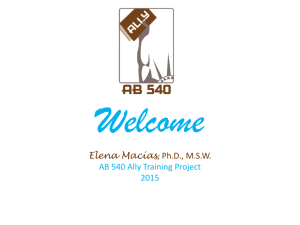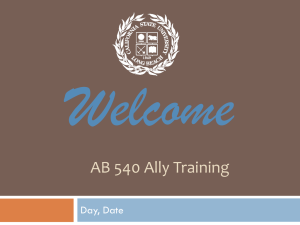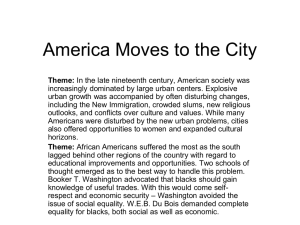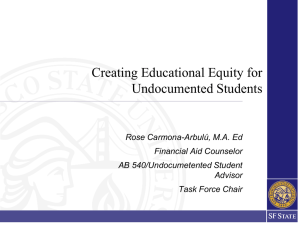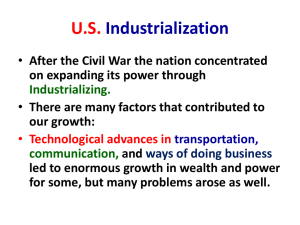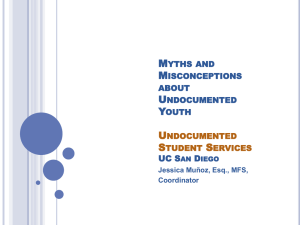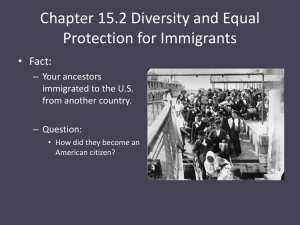AB 540 Ally Training Project - California State University, Long Beach
advertisement
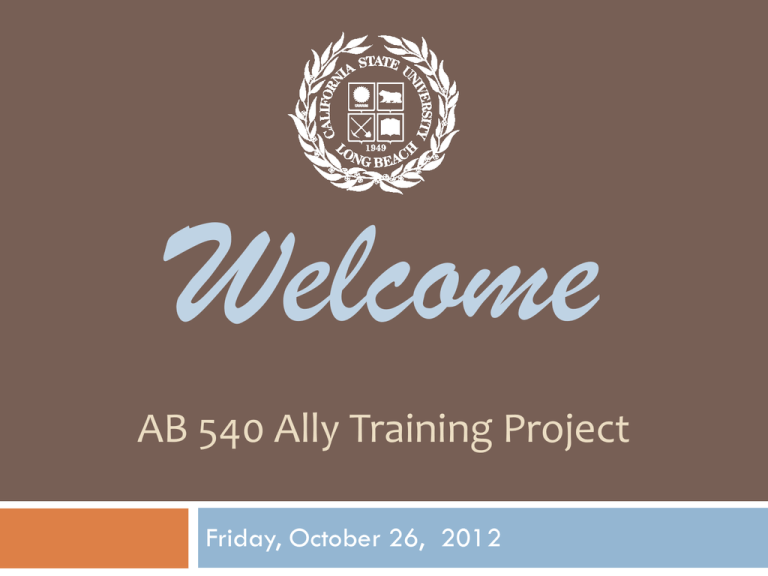
Welcome AB 540 Ally Training Project Friday, October 26, 2012 AB 540 Training Agenda Introductions Self Administered Knowledge Inventory Ground Rules Immigration Experiential AB 540 Overview California Dream Act Deferred Action for Childhood Arrivals (DACA) AB 540 Student Panel Video Policy/Practice Barriers and Challenges AB 540 Student Panel Becoming an Ally Evaluation & Adjourn AB 540 Ally Training Project Introductions Aimee Arreygue Claudia Cotoas Rosalina Camacho Maria Ramirez Christopher Warren Self Administered Knowledge Inventory Goals CSULB aims to achieve greater distinction in four areas: student success, academic quality, service excellence and campus environment Improve immigrant student success Professional development project AB 540 Ally Training Project Objectives Create a welcoming and supportive campus environment for immigrant students, thus assisting their integration into campus life Encourage faculty and staff knowledge and effectiveness about the needs, concerns, and issues of undocumented (unprotected) immigrant students and their families Educate faculty and staff about relevant immigration laws impacting students and related student issues and challenges Ground Rules What do you need to feel safe? Immigration Experiential Purpose is to get in touch with our conceptions about the undocumented and to “step into their shoes” Count off and Gather in small groups Divide your time equally Share your thoughts and feelings with your group about the assigned scenario AB 540 Overview What is AB 540? What is the history of AB 540? Why is the affidavit required? Will US immigration know where to find a student How will The California Dream Act (AB 130/131) be implemented and how can our campuses prepare for this process? What is Deferred Action and how will it impact AB 540 students? AB 540 Overview (cont’d) Provides support for some, but not all unprotected immigrant students Came to US at an early age Raised in US Often do not find out until high school graduation that they are undocumented Some are not covered as AB 540 students because of the requirements Who is eligible? “Any student, except a person in nonimmigrant status, who meets the specific requirements shall be exempt from paying nonresident tuition at all public colleges and universities in California.” What does nonimmigrant status mean? Current nonimmigrant visa holders are not eligible for this tuition exemption: Tourist – F visas and Student – B visa Some expired visa holders who are “out of status” , may not be eligible for AB 540 Students qualified for AB 540 will not be classified as California residents. What are the specific requirements? Attended a California high school for 3 or more years Graduated from a California high school or attained the equivalent of a high school diploma (Passed the GED or California High School Proficiency Examination) Register or be currently enrolled in 1 of the 3 state institutions of higher learning File an affidavit with the institution stating that he/she has applied to legalize his/her status or will do so as soon as eligible to do so What about the AB 540 affidavit? Is required by the college where the student will be attending States that the student will adjust his/her status, as soon as eligible to do so Students are not required to submit a new affidavit when there is continuous enrollment Information on the affidavit is kept confidential, as required by law. Immigration has no access to student information. Exemption Request California Nonresident Tuition Exemption Request http://www.csulb.edu/depts/enrollment/forms/ Impact? How else are undocumented students impacted by their status? Not eligible for federal financial aid programs and federally funded programs No drivers license No SSN, therefore limited in qualifying for anything that requires this form of identification (ID) No work authorization, no paid internships & fellowships Not eligible for some careers when licensure/back ground checks are required Cannot travel when official ID is required Can’t work after graduation Impact? How else are undocumented students impacted by their status? Can receive private, state administered scholarships and private grants Can pay taxes using Individual Taxpayer Identification Number (ITIN) rather than SSN Can use ITIN, Matricula (Mexican ID), Student ID on campus Are eligible for all other campus services Can go to graduate school The California Dream Act of 2011 AB 130 – Campus Administered Scholarships AB 131 – State Institutional Student Financial Aid AB 130 at a Glance Chartered July 7, 2011 Become effective January 1, 2012 All CSU, UC, and CCC administered scholarships are available to AB 540 students Only exception are donor specified recipient requirements for scholarships AB 131 at a Glance (cont’d) Chartered on October 8, 2011 Becomes effective on January 1, 2013 Allows students who meet AB 540 criteria to apply for and receive State institutional grants, like the State University Grant, Educational Opportunity Program and Services, fee waivers and the University of California Grants. CCC students can apply for and receive Board of Governors fee waivers. AB 131 Eligibility Males must register with Selective Service Dependent students must submit parental financial information (taxes) to apply Incoming students are eligible for all forms of state student financial aid, including Cal-Grants, EOP, and BOG Waiver Current students will not have access to Cal-Grants Application is available at: https://dream.csac.ca.gov Political and Legal Context Context is a constant reminder to students and their families Policies and practices fluctuate with the economic and political climate and on going economic need for low wage immigrant labor Historically targeted to specific immigrant groups, i.e., men, Mexicans, Japanese, Chinese, etc. Virtually every group has come to find a “better life in the USA” Deferred Action and Work Authorization Announced June 15, 2012 by the Secretary of Homeland Security as a presidential order; not a law Expanded to include some DREAMers Delays deportation for those in the process Discretion is vital Websites : www.uscis.gov and www.ice.gov What is Deferred Action Status? A form of administrative immigration relief granted by DHS for a two-year period (may be renewable) Allows noncitizens to remain in the U.S. temporarily Permits the person to apply for an employment authorization document (“work permit”) and social security card A person will not accrue “unlawful presence” while in deferred action status Other benefits like driver’s licenses and professional licensure may become available to those that hold a work permit and social security card. Deferred Action Eligibility Age must be over 15* and under 31 as of June 15, 2012 Continuous Presence Came to the U.S. before age 16 Lived in the U.S. continuously from June 15, 2007 to the date of application “Brief, innocent, and casual departures” are ok Education or Military Service (at least one of the following): You are currently in school (public or private- middle school, high school, college, university, vocational training or GED programs) You have a high school diploma or a GED You were honorably discharged from the U.S. Coast Guard or Armed Forces Criminal History Has not been convicted of any of the following: A felony, a significant misdemeanor, or three or more misdemeanors DHS does not consider you: A public safety threat or a national security threat Deferred Action FAQs How do people apply for DACA? Visit www.uscis.gov/childhoodarrivals for the DACA application form, the work permit application form, and instructions. How can I help students connect to resources to learn more about the deferred action process? Lawyers are very important but they will charge Community based programs for guidance and free legal advice What are the fees associated with Deferred Action and are there fee waivers? $380 for work permit application $85 for biometrics No fee waiver, but you can ask for a fee exemption (see website for eligibility) AB 540, AB 130 & 131 and Deferred Action AB 540 Allows a CA high school graduate the privilege of paying in state tuition regardless of immigration status. AB 130&131 Allows an undocumented AB 540 student access to some types of CA financial aid and scholarships. Deferred Action Allows some undocumented youth who are “in school” or who have a high school equivalency to receive a temporary protected status and be eligible to work and travel. Other opportunities for driving privileges, professional licensure, and credentialing may expand Questions What is AB 540? What is the history of AB 540? Why is the affidavit required? Will US immigration know where to find a student after enrolling under AB 540? How do students apply for Deferred Action? Burning Q & A? Effective Mentoring Of Unprotected Students Financial needs are paramount Campus scholarships and state financial aid is available, yet some scholarships require US citizenship or legal residency Challenge these requirements Students should speak with advisor about scholarships and private grants Encourage students to apply for scholarships and financial aid Center for Scholarship Information is a resource Effective Mentoring Of Unprotected Students Apply for an ITIN Leave the SSN on the application blank Explain residency on the application Submit the Nonresident Tuition Exemption Request (Affidavit) after CSULB admissions letter arrives There is a tuition installment plan Effective Mentoring Of Unprotected Students Although they cannot get paid for work, relevant, rigorous work experience is important for their future prospects Encourage students to apply for unpaid internships Help students find alternatives internships when requirements present challenges Career Development Center is a resource Effective Mentoring Of Unprotected Students Are AB 540 Students Eligible for Federal Financial Aid? If a student filed an application with USCIS, the student may already be eligible for resident fee status and also to receive financial aid. Students should speak to their attorney. Utilizing any public benefits while undocumented can be grounds for automatic deportation the day the person is able to adjust his/her immigration status Effective Mentoring Of Unprotected Students Do not use a false SSN Do not complete a FAFSA Do not lie on any application Do not apply for a public benefit for which the person is not entitled Never claim to be a USA citizen File federal and state taxes as appropriate Policy/Practice Barriers and Challenges Identify the campus issues discussed by the students Suggest possible resolutions to the issues Identify policies/practices that have already changed, those that need to change Identify strategies that create a safe and welcoming student advising environment Identify the do’s and don’ts in advising AB 540 Policy/Practice Barriers and Challenges Paying for college is a paramount issue A personal relationship with faculty/staff can motivate students to succeed Students learn about AB 540 informally. Few learn it from a counselor Student identification policies can adversely impact undocumented students if alternative ID is not accepted Internships that require licensure or background checks are not available, so alternatives are needed AB Policy/Practice Barriers and Challenges (cont’d) AB 540 students don’t want pity; they want faculty/staff to do something to positively impact their success Faculty and staff should understand what it means to be an AB 540 student You can open wounds when you are ill informed about AB 540, so keep alternatives in mind when determining class requirements Students want to reveal, but it has to be safe AB 540 Policy/Practice Barriers and Challenges Faculty/staff need to learn what is going on with their students The community political climate regarding immigration impacts AB 540 students and acerbates their challenges When asked a question and you do not know the answer, don’t make one up. It is better to take the time to get the correct answer so their immigration status is not compromised Break 10-minute Break Refreshments Student Panel Name, birth country, age at which arrived in US Major, career dream How the student has experienced being undocumented What the student would like to see in an Ally Brief Q & A at the conclusion of the Panel Process Cultural Proficiency is a Process Becoming an Ally is a Process- a Journey Cultural Destructiveness Cultural Incapacity Cultural Proficiency Cultural Blindness Cultural Pre-competence AB 540 Ally Training Project What is an Ally? In your small group discuss and then present some of the following topics or scenarios to the large group, asking the question, “How would an Ally handle the situation?” Consider the following: Risks and Benefits of Becoming an Ally Effective Ally Strategies A Culturally Proficient Ally Creating an Inclusive Climate Creating alternative practices to assist students to meet academic prerequisites when students are excluded by law from regular participation or placed in a high risk situation Displaying the AB 540 Ally Decal The decal should be displayed in an area belonging solely to the individual who has received it. This will alleviate confusion for a student entering the office at large and allow them to confidently reveal their status to an ally. Ally Contract Questions and Evaluation Burning Q & A Evaluation Thank You New Champions Welcome to the Team! Gloria Inzunza-Franco (562) 985-4202 Jamie Johnson (562) 985-7557 gloria.inzunza-franco@csulb.edu james.johnson2@csulb.edu Jesse Rodriguez, Ed.D. (562) 381-5016 Julie Weise, Ph.D. (562) 985-4703 jesse.rodriguez02@csulb.edu julie.weise@csulb.edu Questions? Call Elena Macias, Ph.D. (562) 985-8816
